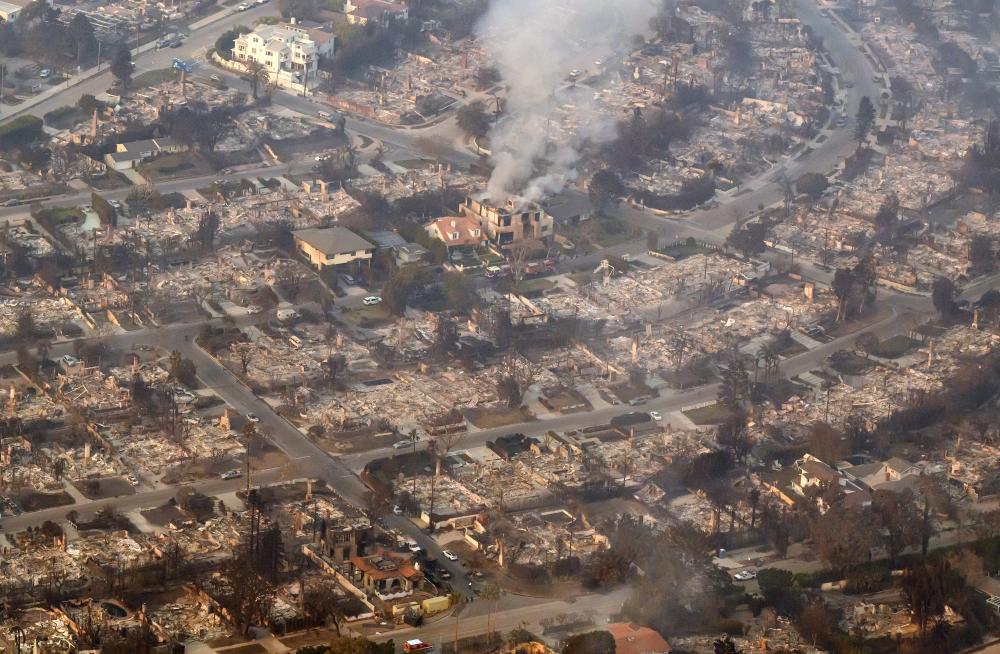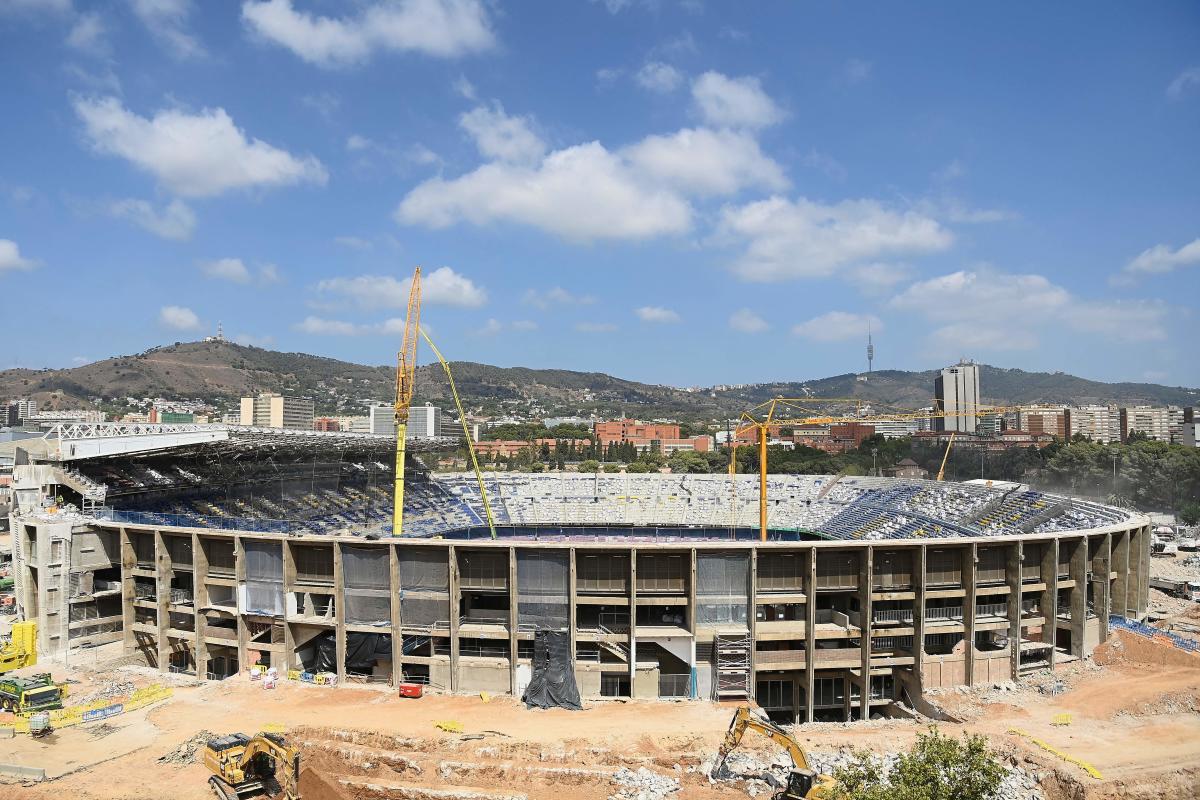
The wildfires raging across the Los Angeles landscape have destroyed many thousands of homes and buildings and damaged hundreds more.
And each property, experts warn, could pose a risk to Angelenos even long after the flames are extinguished.
As residents begin to return to their homes, toxic threats may lurk within whatever they find, cautioned Chris Field, director of the Stanford Woods Institute for the Environment.
Advertisement
Advertisement
At a press conference on Thursday, residents were warned against returning to their homes because of these toxins. Yonah Halpern, a spokesperson with LA county public works, said the Environmental Protection Agency (EPA) and county fire department will be going house-to-house to assess and remove hazardous materials.
Homes and cars contain a multitude of potentially hazardous materials, including lead, battery acid, arsenic and carcinogens found in plastics. Such materials could be contained within the ash of any damaged structure, or have drifted from adjoining properties. And anyone sifting through or cleaning a property without proper protection could face risk of inhaling or absorbing the substances through their skin.
“The chance that there are toxic materials derived from things that were safe before the fire is very high,” Field said. “Those toxics layer on top of the risk that already comes from simply being exposed to large amounts of ash and smoke.”
Longer term, residents should also be conscious of the risks of repeat natural disasters, especially mudslides, said Joshua West, a professor of earth sciences at the University of Southern California and an expert on debris flows, the scientific name for mudslides and similar sudden movements of earth.
Advertisement
Advertisement
Wildfires increase the risk of mudslides by making a landscape vulnerable to swift erosion in the event of a rainstorm, West explains. In January 2018, for example, heavy storms hitting an area in Montecito that had burned in the weeks before triggered a mudslide that killed 23.
While authorities have a pretty good idea of how to evaluate which areas have the most risk of a mudslide following a wildfire, West said, the relative unpredictability of precipitation patterns means it is not an exact science.
“The storm that caused those debris flows dumped an enormous amount of rainfall right over the Montecito area,” West said.
Fortunately, Field and West said, there are a range of precautions property owners can take both now and in the future.
Protecting yourself from toxic risks
As Angelenos consider returning to their properties, West cautions they should first always pay attention to authorities and not return before an evacuation order has been lifted.
Advertisement
Advertisement
More in U.S.
When a home is totally destroyed, Tracey Woodruff, an environmental health expert and director of the Earth Center at the University of California, San Francisco, likened the property to an “uncontrolled hazardous materials incinerator”, noting particularly dangerous materials such as pesticides and the lithium-ion batteries now common in household devices and electric vehicles.
Even tiny shards of glass can pose a risk through inhalation. Typically, cleanup of such properties is performed by professionals or disaster response teams due to all the inherent dangers, and the Californiagovernor, Gavin Newsom, announced on Tuesday that teams were indeed standing by to perform the work as soon as feasible.
While it might be tempting for residents to see if they can find any mementoes or salvageable items before a property is cleared by authorities, Woodruff said the risks outweighed the likelihood of finding anything.
“People who go in and clean up these kinds of properties wear hazmat suits,” she noted, adding that the extremely high temperatures of destructive fires made it very unlikely any valuables would have survived.
Advertisement
Advertisement
Anyone forgoing such advice or returning to a partially damaged property should take precautions, Field added. A well-fitting N-95 mask, goggles and gloves should be the minimum protection, he said, and a professional-grade respirator and full-body Tyvek suit ideal. The Federal Emergency Management Agency also maintains a factsheet with further advice on how to safely search a property for valuables.
Protective measures should be taken even in the event that a house appears to be untouched, Field added, due to the potential for toxic smoke to have drifted in from elsewhere.
“Smoke and toxic dust can create basically a veneer of dangerous materials, even on top of things that haven’t been burned. Everybody should be careful,” he said.
Field advised the use of a water mister to help with cleanup or when moving through an affected property to keep potentially toxic dust from going airborne. Ideally, every material in a home should be treated as if it’s been coated with such material, and wiped down or washed appropriately. And residents should check with local authorities on the proper way of disposing of any larger or hazardous materials.
Advertisement
Advertisement
Woodruff added that children also should not be brought along, because their still-developing bodies are more vulnerable to toxic exposures.
The long-lasting threat of mudslides
Once cleanup is complete, West warned that the risk of mudslides remained. Typically, the greatest danger is within the first year to two years following a wildfire, as natural vegetation to hold the landscape together builds back. But, extremely heavy downpours or other unusual variables can cause the risk to run longer.
The US Geological Survey has developed a tool called the Debris Flow Hazard Assessment Viewer, he said, which considers variables such as topography, burn severity and historic weather patterns to assess the level of risk in a given area. Such information is used by state and local authorities to plan for potential mudslides, but is also available to the public, with the first assessments for the Palisades and Eaton fires expected imminently.
Such information could be used by a homeowner to determine their mudslide risk. But West reiterated it was not an exact science, as was the case in Montecito, where the areas assessed to have the highest amount of mudslide danger took less damage than neighboring areas deemed to have less risk.
A homeowner could hire a professional geotechnical engineer to provide a customized assessment of risk for their property, West added. Typical protective measures include physical measures like sandbags and earthen berms to divert any debris flow away from valuable parts of a property, and keeping an emergency kit ready in case an evacuation order is issued. The California department of public health provides additional readiness tips.
EMEA Tribune is not involved in this news article, it is taken from our partners and or from the News Agencies. Copyright and Credit go to the News Agencies, email news@emeatribune.com Follow our WhatsApp verified Channel




